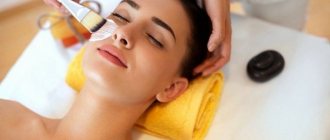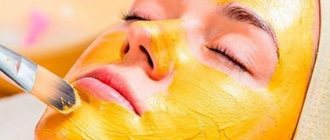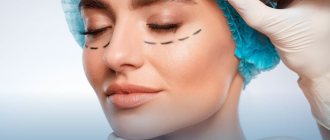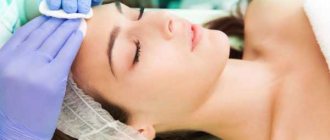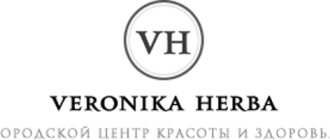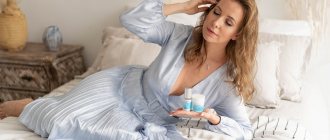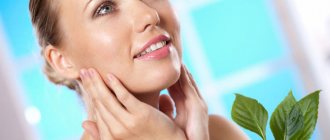Glycolic peels are the most common and popular superficial peels that can be performed by both doctors and cosmetologists and aestheticians. Of all the AHA acids, glycolic acid has the shortest molecule, containing only two carbon atoms, due to which it penetrates deeply into the skin, leads to exfoliation, and has indirect antioxidant and moisturizing effects. To reduce the aggressiveness of the acid, lactokine is added to the peeling composition. This is a one-of-a-kind active substance that contains a group of proteins isolated from milk and has a powerful anti-inflammatory effect.
Benefits of peeling
- Less traumatic and comfortable to carry out
- Does not have systemic effects
- Does not develop addiction
- Minimum rehabilitation period
- Low complication rate
- High efficiency
- Peeling can be used to correct a wide range of aesthetic problems (the optimal indication is age-related changes or prevention of aging)
Indications for peeling
- Skin withering
- Seborrheic skin
- Acne
- Hyperkeratosis
- Hyperpigmentation
- Follicular hyperkeratosis
- Ingrown hair syndrome
- Peeling can be performed as a preparation for other cosmetic procedures.
Contraindications
- Individual intolerance to peeling ingredients
- Violation of the integrity of the skin
- Active inflammatory process on the skin
- Herpes in active phase
- Severe somatic diseases
- Skin types IV–V according to Fitzpatrick
- Pregnancy, lactation
- Prolonged exposure to the sun
Home care products
- Vegelip Mesaltera Moisturizing Cream
- Prepeel Active MCP Pre-Peeling Cream
- Cleanser mousse Medic Control Pee (MCP)
Preparations required for the peeling procedure
- Cleanser mousse MCP
- Glycolic peeling Glycoliсpeel 35%, 50% or 70% (pH 1.7)
- Neutralizer
- Antioxidant mask VC-IP Mask
- Revitalizing cream Vegefarma MCP
Classification of skin peels by depth of damage
Below is a classification of peelings depending on which layer the skin peeling acids penetrate, as well as which peelings represent each group.
Superficial peeling – to the germinal layer of the epidermis (epidermal-dermal junction).
- Glycolic (30 – 50% glycolic acid),
- Milk (10 – 30%),
- Almond (up to 40%, in the case of almond peelings, as a rule, there is a combination with other acids),
- Salicylic (up to 5%, with salicylic peels the depth depends on the percentage and what additional components are contained),
- Pyruvic (up to 50%)
Indications for use: correction of age-related changes (for rejuvenation in all types of aging), acne with inflammation in problem areas of the facial skin (pimples), used when cleansing the skin of sebaceous plugs (comedones) to loosen the epidermis, as well as for age spots.
Potential side effects: post-inflammatory pigmentation, erythema, itching, burning, superficial peeling/epidermolysis
Medium peeling – the entire thickness of the epidermis to the papillary layer of the dermis.
Among the most popular: Jessner peel and its modifications, TCA (trichloroacetic peel), retinol/retinoic (also called “yellow peel”).
Indications for use : affect macrostructural changes in the skin, actively exfoliate, eliminate deeper skin defects (deep pigmentation, post-acne, scars and wrinkles), improve skin texture.
They require a longer recovery period and have an increased risk of scarring and skin dispigmentation.
Deep peeling – up to the reticular layer of the dermis (practically not used in modern cosmetology). The drugs were used on areas with noticeable gross structural disturbances (deep scars, scars).
Currently, aggressive deep peels in cosmetology have practically been abandoned (for example, phenol peels) in favor of safer off-season peels. The reason is the serious complications that arise and the difficult recovery period.
Peels are also available for home use - Home peels are used independently and for professional use - only by specialists in a beauty salon.
Read more about home peeling, what it is, how to choose and use it effectively, here .
Peeling protocol
Stage I. Pre-peeling preparation
For 14–21 days, Prepeel Active cream is applied to the facial skin cleansed with Cleanser mousse at night, depending on the indication. Apply MediScreen sunscreen with antioxidants in the morning.
Stage II. Chemical peeling
1 step. Cleansing. Apply Cleanser mousse to facial skin, spread with light massage movements and leave for 2-3 minutes to 20-30 seconds. Rinse with water. Step 2. Apply the peeling gel with a brush to the entire surface of the facial skin in the direction from the periphery to the center in the following sequence: forehead, temples, chin, eyelids. The signal to begin neutralization is the appearance of signs of erythema and the patient’s subjective sensations in the form of a burning sensation. Exposure time averages from 30 seconds to 5 minutes. If you experience a subjective sensation of intense burning, you should immediately neutralize the peeling composition. Step 3. Using another brush, apply the neutralizing solution to the skin in reverse order. Leave on for 2-3 minutes, then rinse with water. If necessary, repeat neutralization. Step 4 Apply the antioxidant mask VC-IP Mask. Wash off after 10-15 minutes. Dry the skin. Step 5 Apply Vegefarma cream to the skin.
Stage III. Post-peeling care
During the day, the patient should use Vegelip moisturizing cream, apply MediScreen sunscreen in the morning, and Postpeel Light cream at night. Depending on the indications, creams can be used.
Expected reactions after peeling
– Minor erythema that disappears within a few hours after the procedure. – Moderate peeling of the skin.
Peeling programs
The basic course consists of 5–10 procedures, which are performed at intervals of 7–14 days.
- For age-related skin changes, to prevent biological (natural) aging, the procedure is carried out once every 10–14 days. The intensive course includes 10 procedures 1–2 times a year. Maintenance course – 1 procedure every 1–1.5 months. In sessions 1–3, 35%–50% glycolic acid is used, starting from session 4 – 70%. The exposure time of the peeling solution is strictly individual.
- To prevent photoaging, peeling is performed once every 7–10 days. The intensive course consists of 6–10 procedures once a year. Maintenance course – 1 procedure every 1–1.5 months. In sessions 1–3, 35%–50% glycolic acid is used, starting from session 4 – 70%. The exposure time of the peeling solution is strictly individual.
- For seborrhea, peeling is performed with 35% and 50% glycolic acid once every 7–10 days. The course is selected individually.
- For acne, peeling is performed with 35% and 50% glycolic acid once every 7–10 days. Peeling is performed for mild acne (no more than 7–10 inflammatory elements). It is preferable to begin the course of treatment with peelings with salicylic or mandelic acids.
- For hyperkeratosis, formulations of varying concentrations are used depending on the age of the patient. The course includes up to 10–12 procedures.
- For hyperpigmentation, it is recommended to use Glycolicpeel Whitening peel in combination with depigmentation therapy with Medilight. The main rule is to carefully influence areas of dyschromia!
- In preparation for plastic surgery, a course is prescribed consisting of 5-6 procedures with 50% acid, then 3-4 procedures with 70% acid with an interval of 10-14 days.
Types of facial peels
There are only three of them:
- Mechanical peeling
Involves exfoliating the skin using an abrasive (scrubs, dermabrasion). In professional cosmetology, this type of skin peeling is used less and less. Mechanical peeling is indicated for rough, dense skin with good epithelization.
- Laser peeling (resurfacing, dermabrasion)
An effective but traumatic peeling procedure with a serious recovery period for the skin.
- Chemical peeling
It is most popular among skin peels due to the breadth of indications for its implementation, the possibility of selection according to the depth of penetration and the most suitable composition.
4. Enzyme peeling
Enzyme peels are considered the weakest and most atraumatic, and are sometimes performed before the chemical peel procedure in order to prepare it for deeper penetration of acids in subsequent stages. And also for contraindications to chemical peels.
— That is, you do not recommend doing medium and deep types of peeling at home?
- I absolutely do not recommend it. If the product is intended for superficial peeling, it means that it will act exclusively in the upper, stratum corneum layer of the skin; accordingly, even if something goes wrong, the risk of side effects is very small. Superficial home facial peeling does not require a rehabilitation period - everything goes unnoticed, after which only slight peeling of the skin is possible.
Medium peeling acts down to the basal layer of the skin, and deep peeling completely destroys the basal layer and affects the dermis. Medium and deep peels are not always easy to apply, and most importantly, they have a rehabilitation period that can only be carried out under the supervision of a doctor. Some types of deep peeling can only be performed by plastic surgeons and only in specialized medical institutions!
How often can you use homemade skin peeling?
Home peels are superficial and can be mechanical or chemical. Selected according to skin type and problem.
Let's look at specific examples:
DermaQuest facial scrub cleansing gel with alginates is a gel scrub based on algae extracts and jojoba granules for effective cleansing and moisturizing - removes hyperkeratosis and prepares the skin for subsequent stages of care. Intensively “rinses”, increasing the depth of subsequent treatments.
Contains and plant extracts , as well as jojoba granules for gentle effusion of excess stratum corneum.
Recommended for all skin types, including dry, dehydrated and sensitive.
Application: 2 times a week for oily, thick skin or combination skin, 1 time a week for dry and sensitive skin.
DermaQuest pumpkin face mask is a homemade peeling for oily skin with comedones and enlarged pores.
Steaming mask with antibacterial effect for deep cleansing of the skin: dissolves comedones, draws out inflammatory elements and promotes their maturation, removes inflamed acne. Active lymphatic drainage. Gives the skin a well-groomed, neat appearance.
Application: intervals between procedures are 1 week.
Mechanical cleaning
A popular question is how often mechanical peeling is used. Its peculiarity is that it does not affect the deep layers of the dermis and is quite gentle. A procedure is performed to cleanse the skin of dirt and remnants of dead epidermis in order to speed up metabolic processes.
This cleaning is usually done manually using special tools.
There may be minor discomfort during execution, but there is no pain. If your skin is oily and problematic, it will become cleaner and look healthier. During the manipulation, comedones are eliminated, pores can be narrowed, and acne can be removed. Indications for performing the manipulation are enlarged pores and oily skin, the presence of comedones and acne, if there are wen. The procedure is not performed for herpes, allergic dermatosis, if the blood vessels are highly fragile, or if the skin is very thin and sensitive. How often to do facial peeling, check with our cosmetologist during your consultation.
— What complications can arise after peeling at home and how to deal with them?
— There can be a lot of complications, but encountering them can be avoided if you pay attention to the indications and contraindications for the use of cosmetics intended specifically for home use.
And, I repeat, strictly follow the instructions. Unfortunately, many patients tend to violate the rules of use - for example, leave the product on longer, instead of the recommended 10 minutes, leave it for the entire 15 - “so that there is definitely an effect.” As a result, the effect will not increase, but, on the contrary, unforeseen problems will arise. If the instructions say “if you feel a burning sensation, remove the product immediately,” then you should not ignore this warning and stoically endure until the last. You should not take such liberties during home peeling.
There is no need to eliminate complications on your own; it is better to consult a doctor immediately. The most common complication after peeling is pigmentation, which you have to put up with for several weeks or months. Pigmentation occurs, among other things, due to non-compliance with the rules of post-peeling care.


